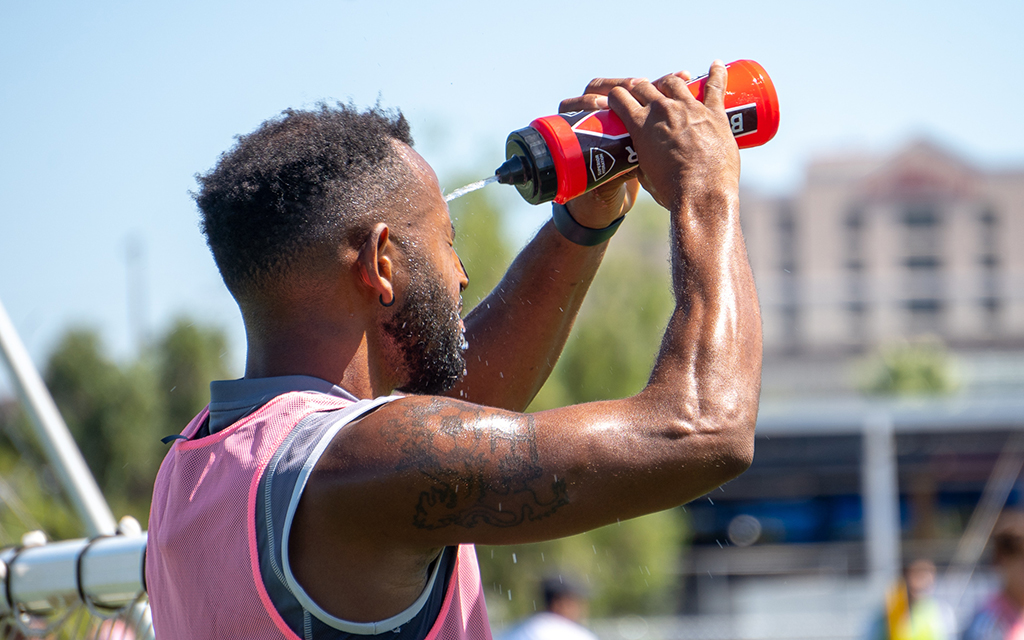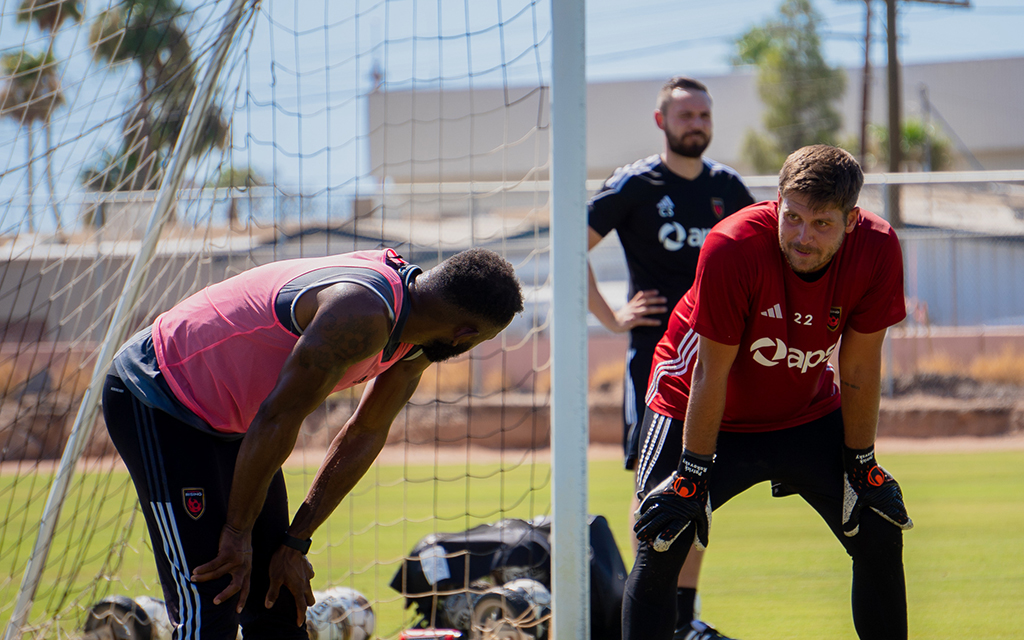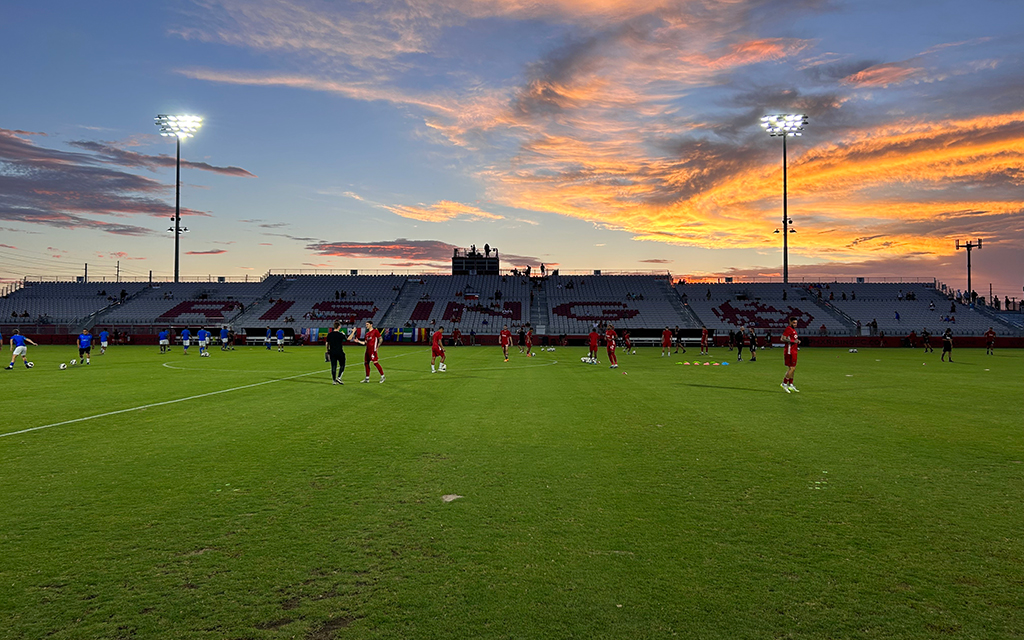
Phoenix Rising FC’s strategic scheduling of evening home games provides players like Darnell King with a cooler playing surface and better conditions on the pitch. (Photo courtesy of Isabella Duran/Phoenix Rising)
PHOENIX – Back in March, as the USL Championship season’s first whistle blew, Phoenix Rising FC was set for business as usual. Yet, with each month passing, the team was dealt a challenge that transcends the confines of the pitch – a battle for athlete safety in the midst of the Valley’s record heat.
During Phoenix’s relentless 31-day stretch of 110-degree highs, punctuated by three scorching days in July at 119 degrees, the Phoenix Rising had no choice but to adapt to these conditions during regular season play.
Seemingly, the unique challenges of training and competing in this unprecedented heat are often overlooked. Following a recent practice, coach Juan Guerra was asked about the impact the record-breaking summer had on the season. His complexion told the story.
“That’s a fantastic question,” Guerra said. “Look at my face, I’m still red. It’s 115 degrees out there. It’s a massive challenge we’ve had for two and a half months.”
With a schedule that runs through the summer and culminates in October, the Rising players are used to dealing with harsh temperatures six to seven days a week, juggling games once or twice weekly alongside their demanding training schedule.
So how does a professional organization address the heat? What have been hydration strategies and food strategies to help prevent heat-related issues? What are the recommended protocols for modifying training routines or adjusting schedules to minimize the risk of heat-related injuries?

Phoenix Rising teammates Darnell King, left, and Patrick Rakovsky take a breather during a recent practice. The USL mandates cooling breaks during matches played in extreme heat, offering players a crucial respite to beat the desert sun. (Photo courtesy of Isabella Duran/Phoenix Rising)
Training Routines and Schedules
Regulating players’ exposure to the sun is a necessity, a task that must be monitored from sunrise to sunset, said Greg Spence, a trainer for the Rising.
“If there’s a possibility that we can get them in the shade to do a stretching routine or a lift, then we utilize the facilities that we have. We do as much as we can, in here, as far as preventative maintenance and exercise programs,” said Spence, referring to the club’s indoor lifting facilities.
“And of course, we monitor the heat index. You can be dynamic inside. Then, once you get outside, you can start involving more of the ball to get your mind involved as far as that goal-oriented, ball-oriented stuff.”
To avoid the daily heat, practice typically begins anywhere between 8:30-10:30 a.m., ensuring that players will spend no more than 70 minutes under the sun.
On game day, the Rising strategically schedule their home games no earlier than 7:30 p.m..
Phoenix Rising Stadium and the practice field are both grass pitches, which tend to be significantly cooler than artificial turf. Grass allows for the release of water vapor through transpiration, which prevents temperatures from rising above 100 degrees.

Phoenix Rising FC’s summer schedule calls for innovative strategies under the Valley’s record-breaking temperatures. (Photo by Dylan Ackermann/Cronkite News)
Having a plan
Guerra said hydration and food strategies for the players are not only vital during their time at the practice facility, but also in their off hours.
“So for us, the most important thing is providing,” Guerra said. “Providing and serving the players, making sure that it’s not only what we do here, but also what they are doing when they’re not here.”
Spence added, “We always encourage proper hydration the day before a tough training session or a day before a game. That usually includes at least a gallon of water throughout the day and then whatever you lose during training, we try to regain that as much as possible as far as water weight is concerned.
“As far as nutrition is concerned, we do a good job of making sure that their meals are well rounded, they’re getting adequate nutrients, so that they can absorb all the vitamins that are needed to help their bodies restore.”
The 11-8-8 Rising won their third match in eight days last Saturday, beating Rio Grande Valley Toros 2-0 to jump into fourth place in the Western Conference. With more extreme heat predicted over the next week and their next home game scheduled for Sept. 16, the Rising can’t risk letting down their guard.
During matches played in intensely hot or humid conditions, the USL mandates the use of cooling breaks, based on the wet globe thermometer. “Each break will last up to three minutes and be held approximately 30 minutes into each half,” reads a poster in the locker room.
Rising defender John Stenburg arrived in the Valley on Aug. 2 on loan from Swedish Club Östers IF. He thought he was well-prepared for the desert heat following a record-breaking summer in Sweden, but Phoenix’s weather was a whole different ball game.
“It’s been hot, I can tell you that,” Stenburg said. “I came from Sweden and in Sweden we also had a record-breaking summer. But on the other half it has been cold in Sweden, so it’s been different. But yeah, the first two weeks were a bit tough for me. I lost a lot of kilos and so on but I adapted, so I got used to it.”
When it comes to achieving peak performance and recovery in heightened temperatures, Stenburg’s mantra is straightforward, thanks to the guidance of the training staff and his own experiences.
“For me it’s about resting,” Stenburg said. “It’s about eating a lot and it’s about hydration. I have never been somewhere where I drink as much as I do here. So that’s the key for me: to eat, drink and sleep.”

